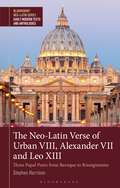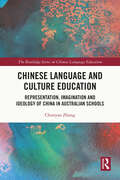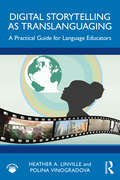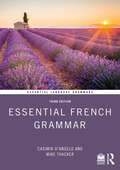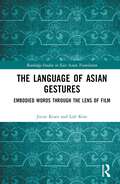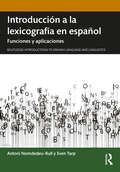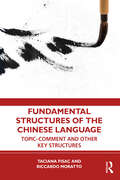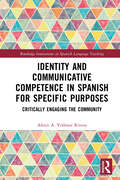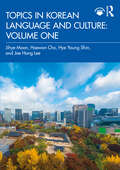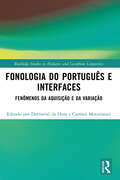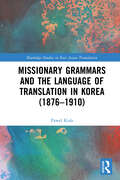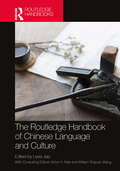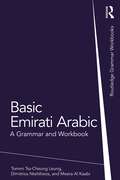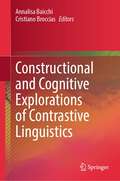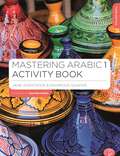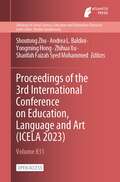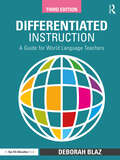- Table View
- List View
The Neo-Latin Verse of Urban VIII, Alexander VII and Leo XIII: Three Papal Poets from Baroque to Risorgimento (Bloomsbury Neo-Latin Series: Early Modern Texts and Anthologies)
by Stephen HarrisonA fascinating insight into the most talented Latin poets to occupy the Papal throne after Pius II Piccolomini in the 15th century, this book offers translations of and commentaries on the major poems of the three popes (all Italians): Urban VIII Barberini, Alexander VII Chigi and Leo XIII Pecci. Their highly accomplished Neo-Latin poems owe much to the major Latin poets and are significant instances of classical reception, but also cast an interesting light on their lives, times and papacies.Urban (elected pope in 1623) published a mixture of secular and religious verse, drawing on the hexameter epistles of Horace and the lyrics of Catullus and writing Horatian material in praise of Alessandro Farnese, governor of the Netherlands for Philip II of Spain, and the Spanish martyr St Laurence. Alexander (elected pope in 1655) like Urban combines secular and religious themes and often uses Horatian frameworks, writing hexameter accounts of some of the journeys he made as a papal diplomat in Germany and an Horatian ode on the fall of the Protestant stronghold of La Rochelle (1628). Leo's poetry was mostly religious and published during his papacy (1878-1903); his Horatian ode on the new millennium of 1900 was widely read, and other works include an elegy which links a shrine of the Virgin with the Battle of Lepanto; an Horatian satire on moderate diet; and hymns to saints which combine early Christian and Horatian forms.
Chinese Language and Culture Education: Representation, Imagination and Ideology of China in Australian Schools (The Routledge Series on Chinese Language Education)
by Chunyan ZhangAgainst the background of the Australian government’s strategic plan to promote Asian languages in schools, this book is an innovative autoethnographic inquiry into what actually occurs in the implementation of a Chinese language and culture program in an Australian context.Drawing on eight years of socio-cultural and educational fieldwork in a primary school, Chunyan Zhang examines complex, fluid and heterogeneous daily teaching practices and the ways in which ideas of China are assembled, presented and performed. She asks the following questions: What is China? Where does Taiwan fit into the China depicted in a multicultural, globalised classroom? Can Chinese communism or Chairman Mao be avoided in teaching English-speaking learners? What kind of China is brought in here while what kind of China is being silenced and othered? Through the partial connection between method assemblage and Daoist concepts, Zhang develops a water-like pedagogy in teaching. She uses the knowledge flow model to examine the imbalanced knowledge flow within teacher-student interactions. From finding China as a hybrid assemblage to proposing China as method, Zhang’s investigation makes an important contribution to the sociology of Chinese language education.This book is an essential and rich content resource for primary and secondary teacher education and research, teacher candidates and educators in Chinese as a second language education.
Digital Storytelling as Translanguaging: A Practical Guide for Language Educators
by Heather A. Linville Polina VinogradovaThis innovative, accessible book is an introduction to using digital storytelling in language teaching, with a focus on English as an Additional Language (EAL) instruction. Linville and Vinogradova provide a clear framework that addresses translanguaging and multimodal meaning making in teaching multilingual learners (MLs) through use of digital storytelling.This book provides detailed guidance on how to incorporate digital storytelling into language teaching, building on recent developments in the fields of TESOL and language education that position multilingualism and multiliteracies as important components of any language instruction. Through this text and accompanying activities, readers will understand how to work with MLs to create multimodal digital texts. This book offers an easy-to-follow, step-by-step process for language educators to follow to support MLs’ digital storytelling projects in any EAL classroom. Featured digital storytelling projects from EAL practitioners in various contexts, as well as multiple examples and resources, are included for each stage of the process, always grounded in contemporary TESOL theories (e.g., critical pedagogy, culturally responsive teaching, translanguaging, and a pedagogy of multiliteracies). This framework supports the development of multilingualism and multiliteracies and can be adapted by educators of other world languages for any language education setting.Grounded in contemporary TESOL theories, this book is an essential text for courses on technology in TESOL and TESOL methods courses, as well as for language educators.
Digital Storytelling as Translanguaging: A Practical Guide for Language Educators
by Heather A. Linville Polina VinogradovaThis innovative, accessible book is an introduction to using digital storytelling in language teaching, with a focus on English as an Additional Language (EAL) instruction. Linville and Vinogradova provide a clear framework that addresses translanguaging and multimodal meaning making in teaching multilingual learners (MLs) through use of digital storytelling.This book provides detailed guidance on how to incorporate digital storytelling into language teaching, building on recent developments in the fields of TESOL and language education that position multilingualism and multiliteracies as important components of any language instruction. Through this text and accompanying activities, readers will understand how to work with MLs to create multimodal digital texts. This book offers an easy-to-follow, step-by-step process for language educators to follow to support MLs’ digital storytelling projects in any EAL classroom. Featured digital storytelling projects from EAL practitioners in various contexts, as well as multiple examples and resources, are included for each stage of the process, always grounded in contemporary TESOL theories (e.g., critical pedagogy, culturally responsive teaching, translanguaging, and a pedagogy of multiliteracies). This framework supports the development of multilingualism and multiliteracies and can be adapted by educators of other world languages for any language education setting.Grounded in contemporary TESOL theories, this book is an essential text for courses on technology in TESOL and TESOL methods courses, as well as for language educators.
Essential French Grammar (Essential Language Grammars)
by Casimir d'Angelo Mike ThackerEssential French Grammar is a student-friendly French grammar designed to give learners a firm foundation on which to build a real understanding of both spoken and written French. Clear explanations of grammar are supported by contemporary examples, lively cartoon drawings, and a variety of exercises.Key features of the textbook include: each grammar point explained initially with reference to English parallels between English and French provided where relevant ‘Key points’ boxes and tables that summarize grammar concepts real-life language examples in French, with English translations a variety of exercises to reinforce learning a contemporary primary source or literary extract to illustrate grammar in context detailed coverage of punctuation, accents, spelling, and the specific sounds of French An introductory chapter describes the lexical and grammatical differences between French and English and a glossary of grammatical terms in French and English, useful verb tables, and an exercise key are also provided, making this an ideal resource for both independent and class-based learners. This third edition offers additional activities throughout, describes the much-debated practice of inclusive language in French and includes a brief history of the influence of French words on English vocabulary. Further grammar practice, in the form of quizzes, is to be found in the instructor and student resources for Essential French Grammar at www.routledge.com/cw/essential-grammars.An innovative reference grammar and workbook for intermediate and advanced undergraduate students of French, Essential French Grammar is ideal for students at CEFR levels B1 to C1, or Intermediate High to Advanced on the ACTFL scale.
The Language of Asian Gestures: Embodied Words Through the Lens of Film (Routledge Studies in East Asian Translation)
by Jieun Kiaer Loli KimThe Language of Asian Gestures explores Asian gestures as a non-verbal language within the context of films and dramas.This book provides a cross-cultural Asian perspective on a range of important common gestures and their meanings, covering a range of Asian regions including Korea, China, Hong Kong, Japan, Taiwan, Vietnam, Singapore, Thailand, Indonesia, the Philippines, India, and Pakistan. While most studies focus on text-based communication, gestures find themselves overshadowed by text and speech. Asian gestures, too, often reside in the shadow of Eurocentric viewpoints. This book will shift this dynamic and amplify the voices that have typically been marginalised within 20th-century Eurocentric discussions.The book will be informative for students and researchers interested in Asian languages, cultures, film studies, and pragmatics. It bridges the gap between words and gestures, unveiling a world of concealed meanings and enriching our understanding of diverse forms of expression.
The Language of Asian Gestures: Embodied Words Through the Lens of Film (Routledge Studies in East Asian Translation)
by Jieun Kiaer Loli KimThe Language of Asian Gestures explores Asian gestures as a non-verbal language within the context of films and dramas.This book provides a cross-cultural Asian perspective on a range of important common gestures and their meanings, covering a range of Asian regions including Korea, China, Hong Kong, Japan, Taiwan, Vietnam, Singapore, Thailand, Indonesia, the Philippines, India, and Pakistan. While most studies focus on text-based communication, gestures find themselves overshadowed by text and speech. Asian gestures, too, often reside in the shadow of Eurocentric viewpoints. This book will shift this dynamic and amplify the voices that have typically been marginalised within 20th-century Eurocentric discussions.The book will be informative for students and researchers interested in Asian languages, cultures, film studies, and pragmatics. It bridges the gap between words and gestures, unveiling a world of concealed meanings and enriching our understanding of diverse forms of expression.
Introducción a la lexicografía en español: Funciones y aplicaciones (Routledge Introductions to Spanish Language and Linguistics)
by Antoni Nomdedeu-Rull Sven TarpIntroducción a la lexicografía en español. Funciones y aplicaciones ofrece una descripción innovativa de la historia lexicográfica en español, una crítica constructiva de los diccionarios existentes y una visión transformativa y optimista de la disciplina relacionada con las nuevas tecnologías. Basado en la teoría funcional de la lexicografía con un enfoque centrado en el usuario y sus necesidades de información, el libro contribuirá, sin duda, al "renacimiento" de la lexicografía en español. Su punto de partida es la detección de esas necesidades, la generación de datos que ayuden a resolverlas y la presentación de esos datos a los usuarios mediante un diseño de uso intuitivo.Características principales: Establecimiento de conceptos fundamentales de la lexicografía; Exposición de las tendencias principales en la lexicografía en español; Explicación de las fases para realizar un proyecto lexicográfico; Discusión de los métodos y técnicas de compilación más recientes; Propuestas de soluciones a problemas viejos y nuevos. Con su enfoque tanto descriptivo como transformativo, este libro es un recurso indispensable para cualquier investigador, profesor o estudiante de grado y posgrado que busque conocimientos más profundos de los diccionarios y productos similares en español.
Introducción a la lexicografía en español: Funciones y aplicaciones (Routledge Introductions to Spanish Language and Linguistics)
by Antoni Nomdedeu-Rull Sven TarpIntroducción a la lexicografía en español. Funciones y aplicaciones ofrece una descripción innovativa de la historia lexicográfica en español, una crítica constructiva de los diccionarios existentes y una visión transformativa y optimista de la disciplina relacionada con las nuevas tecnologías. Basado en la teoría funcional de la lexicografía con un enfoque centrado en el usuario y sus necesidades de información, el libro contribuirá, sin duda, al "renacimiento" de la lexicografía en español. Su punto de partida es la detección de esas necesidades, la generación de datos que ayuden a resolverlas y la presentación de esos datos a los usuarios mediante un diseño de uso intuitivo.Características principales: Establecimiento de conceptos fundamentales de la lexicografía; Exposición de las tendencias principales en la lexicografía en español; Explicación de las fases para realizar un proyecto lexicográfico; Discusión de los métodos y técnicas de compilación más recientes; Propuestas de soluciones a problemas viejos y nuevos. Con su enfoque tanto descriptivo como transformativo, este libro es un recurso indispensable para cualquier investigador, profesor o estudiante de grado y posgrado que busque conocimientos más profundos de los diccionarios y productos similares en español.
Fundamental Structures of the Chinese Language: Topic-Comment and Other Key Structures
by Taciana Fisac Riccardo MorattoFundamental Structures of the Chinese Language is an exceptional resource for understanding how Chinese grammar functions in natural discourse.This book departs from the conventional approach of superimposing grammatical constructs from English onto Chinese and focuses on the topic–comment structure inherent in the Chinese language. Constructions that are usually considered complex or challenging for students whose mother tongues are subject–verb–object languages will be more easily understandable with this analysis. Simple and complex verbal structures are discussed in depth with the incorporation of the aspect category, which provides an enormous richness of nuances in the internal development of the action, and word order is considered one of the key features of the Chinese language. All the explanations are applied to numerous examples of real Chinese texts.This textbook is a valuable resource for students, teachers, and researchers in Chinese language courses including Chinese translation, Chinese linguistics, and comparison linguistics in general.
Fundamental Structures of the Chinese Language: Topic-Comment and Other Key Structures
by Taciana Fisac Riccardo MorattoFundamental Structures of the Chinese Language is an exceptional resource for understanding how Chinese grammar functions in natural discourse.This book departs from the conventional approach of superimposing grammatical constructs from English onto Chinese and focuses on the topic–comment structure inherent in the Chinese language. Constructions that are usually considered complex or challenging for students whose mother tongues are subject–verb–object languages will be more easily understandable with this analysis. Simple and complex verbal structures are discussed in depth with the incorporation of the aspect category, which provides an enormous richness of nuances in the internal development of the action, and word order is considered one of the key features of the Chinese language. All the explanations are applied to numerous examples of real Chinese texts.This textbook is a valuable resource for students, teachers, and researchers in Chinese language courses including Chinese translation, Chinese linguistics, and comparison linguistics in general.
Identity and Communicative Competence in Spanish for Specific Purposes: Critically Engaging the Community (Routledge Innovations in Spanish Language Teaching)
by Alexis A. Vollmer RiveraIdentity and Communicative Competence in Spanish for Specific Purposes analyzes the experiences of three Spanish for specific purposes (SSP) students, offering insight into the intersectionality of society, politics, identity, and linguistics in community-based settings.Analyses provide empirical evidence to a growing body of work about how experiential language learning (EX-LL) enhances student preparation to utilize target languages in professional services. Ethnographic portraits and discourse analysis also illustrate how EX-LL, such as internships, provides students with opportunities to position and protect their identities using linguistic and extralinguistic resources. Discussions are presented throughout the volume on how to implement EX-LL from a critical perspective that supports students while mutually benefiting community members. Harnessing community members’ stories to contextualise and illustrate the disparities U.S. Hispanic/Latinx communities face in accessing high-quality care and services, the volume proposes SSP as a form of advocacy to narrow this gap while simultaneously enhancing students’ skills in Spanish.Designed for graduate students, educators, researchers, and program developers in SSP, second language acquisition, heritage language pedagogy, and sociolinguistics, this volume will prompt the reader to (re)imagine how language learning traverses society, politics, and identity in community-based settings.
Identity and Communicative Competence in Spanish for Specific Purposes: Critically Engaging the Community (Routledge Innovations in Spanish Language Teaching)
by Alexis A. Vollmer RiveraIdentity and Communicative Competence in Spanish for Specific Purposes analyzes the experiences of three Spanish for specific purposes (SSP) students, offering insight into the intersectionality of society, politics, identity, and linguistics in community-based settings.Analyses provide empirical evidence to a growing body of work about how experiential language learning (EX-LL) enhances student preparation to utilize target languages in professional services. Ethnographic portraits and discourse analysis also illustrate how EX-LL, such as internships, provides students with opportunities to position and protect their identities using linguistic and extralinguistic resources. Discussions are presented throughout the volume on how to implement EX-LL from a critical perspective that supports students while mutually benefiting community members. Harnessing community members’ stories to contextualise and illustrate the disparities U.S. Hispanic/Latinx communities face in accessing high-quality care and services, the volume proposes SSP as a form of advocacy to narrow this gap while simultaneously enhancing students’ skills in Spanish.Designed for graduate students, educators, researchers, and program developers in SSP, second language acquisition, heritage language pedagogy, and sociolinguistics, this volume will prompt the reader to (re)imagine how language learning traverses society, politics, and identity in community-based settings.
Topics in Korean Language and Culture: Volume One
by Jihye Moon Haewon Cho Hye Young Shin Jae Hong LeeTopics in Korean Language and Culture: Volume One covers 12 essential topics relating to both traditional and contemporary Korean culture and society.Each chapter consists of listening and reading passages, key expressions and grammar, and performance-based activities unfolding across different modes of oral and written communication. The grammar section is organized into foundation review, semantic distinction, and language function to help learners advance beyond the plateau of intermediate proficiency. All passages are carefully written to resemble authentic texts used by Korean native speakers and to include various text types and speech styles that learners will encounter in real life.The first volume specifically targets students in their third year of learning Korean. It is designed to accommodate a wide range of courses and curricula existing for Korean programs today. It is intended for a yearlong language sequence as well as an intensive topic course in speaking, reading, or writing.
Topics in Korean Language and Culture: Volume One
by Jihye Moon Haewon Cho Hye Young Shin Jae Hong LeeTopics in Korean Language and Culture: Volume One covers 12 essential topics relating to both traditional and contemporary Korean culture and society.Each chapter consists of listening and reading passages, key expressions and grammar, and performance-based activities unfolding across different modes of oral and written communication. The grammar section is organized into foundation review, semantic distinction, and language function to help learners advance beyond the plateau of intermediate proficiency. All passages are carefully written to resemble authentic texts used by Korean native speakers and to include various text types and speech styles that learners will encounter in real life.The first volume specifically targets students in their third year of learning Korean. It is designed to accommodate a wide range of courses and curricula existing for Korean programs today. It is intended for a yearlong language sequence as well as an intensive topic course in speaking, reading, or writing.
Fonologia do Português e Interfaces: Fenômenos da Aquisição e da Variação (Routledge Studies in Hispanic and Lusophone Linguistics)
by Dermeval Da Hora Carmen Matzenauer Javier Muñoz-BasolsFonologia do Português e Interfaces: Fenômenos da Aquisição e da Variação brings together a collection of studies on phonological acquisition and phonological variation in European and Brazilian Portuguese, addressing topics and proposing analyzes that are little studied in linguistic research in the target language.The eleven chapters foster theoretical debates on the processes underlying both phonological acquisition and variation and show how these are interrelated. They focus on the acquisition of phonology by children as well as adult variation in the use of phonological units in everyday speech, highlighting linguistic processes that occur in both contexts. The volume combines theory and practices with a focus on language teaching and acquisition.The book will be of interest to Lusophony linguists, particularly those interested in phonological acquisition and variation, and should prove useful to linguistic researchers, practitioners, and students of Portuguese in Europe, Latin America, and the US.Fonologia do Português e Interfaces: Fenômenos da Aquisição e da Variação reúne uma coletânea de estudos sobre aquisição fonológica e variação fonológica no Português Europeu e Brasileiro, com a abordagem de tópicos e a proposição de análises pouco estudados na pesquisa linguística na língua-alvo.Os onze capítulos promovem debates teóricos sobre os processos subjacentes tanto à aquisição quanto à variação fonológica e mostram como estão inter-relacionados. Concentram-se em unidades fonológicas na fala cotidiana na aquisição da fonologia por crianças, bem como na variação na fala de adultos, destacando os processos linguísticos que ocorrem em ambos os contextos. O volume combina teoria e prática com foco no ensino e na aquisição da língua.O livro será de interesse para linguistas da Lusofonia, particularmente para aqueles voltados para a aquisição e a variação fonológica, e deverá ser útil para pesquisadores da área da Linguística, para usuários da língua e para estudantes de Português na Europa, na América Latina e nos Estados Unidos.
Missionary Grammars and the Language of Translation in Korea (Routledge Studies in East Asian Translation)
by Paweł KidaMissionary Grammars and the Language of Translation in Korea (1876−1910) embraces the Enlightenment period in Korea (1876−1910) after the opening of the so-called Hermit Nation in describing the Korean language and missionary works.This book includes a comprehensive analysis and description of works published at that time by John Ross (1877, 1882), Felix-Clair Ridel (1881), James Scott (1887, 1893), Camille Imbault-Huart (1893), Horace Grant Underwood (1890, 1914), James Scrath Gale (1894, 1903), and Annie Laurie Baird (1911) with the particular focus on missionary activities, linguistic practices, grammatical content, and the language of translation from Korean into a native language. The topic of missionary grammar was raised by Otto Zwartjes (2012, 2018) with a focus on South America, North America, and Portuguese missions in Asia and Africa. Still, so far, Korea had not been mentioned, and there has been missing content about missionary grammar in Korea. A necessary study has been made within the framework of AMG (Average Missionary Grammar). The author has concluded that missionary works played an essential role in the formation of further linguistic research in Korea. The Greek-Latin approach applied by Western missionaries to the language is still relevant in the grammatical description of the Korean language.This book will primarily appeal to Korean language educators, researchers, and historical linguists. Postgraduates interested in missionary grammar will also benefit from the content of this volume.
The Routledge Handbook of Chinese Language and Culture (Routledge Language Handbooks)
by Liwei Jiao Victor H. Mair William Shiyuan WangThe Routledge Handbook of Chinese Language and Culture represents the first English anthology that delves into the fascinating and thought-provoking relationship between the Chinese language and culture, exploring various macro and micro perspectives.Chinese culture boasts a history of ten thousand years, while the Chinese language’s recorded history spans at least three thousand years, dating back to the Shang dynasty oracle bone inscriptions (OBI).This handbook is comprised of 17 chapters from 18 scholars including Victor Mair and William S-Y. Wang. Many chapters approach their respective topics with a comprehensive and historical outlook. Certain extensive subjects are addressed in multiple chapters, complementing one another. These topics include: The languages and peoples of China, and the southern Chinese dialects Mandarin’s evolution into a national language and its related writing reforms Language as a propaganda tool in the Cultural Revolution and in contemporary China Chinese idioms and colloquialisms This book offers an approachable exploration of the subject, appealing to both specialists and enthusiasts of the Chinese language and culture.
The Routledge Handbook of Chinese Language and Culture (Routledge Language Handbooks)
The Routledge Handbook of Chinese Language and Culture represents the first English anthology that delves into the fascinating and thought-provoking relationship between the Chinese language and culture, exploring various macro and micro perspectives.Chinese culture boasts a history of ten thousand years, while the Chinese language’s recorded history spans at least three thousand years, dating back to the Shang dynasty oracle bone inscriptions (OBI).This handbook is comprised of 17 chapters from 18 scholars including Victor Mair and William S-Y. Wang. Many chapters approach their respective topics with a comprehensive and historical outlook. Certain extensive subjects are addressed in multiple chapters, complementing one another. These topics include: The languages and peoples of China, and the southern Chinese dialects Mandarin’s evolution into a national language and its related writing reforms Language as a propaganda tool in the Cultural Revolution and in contemporary China Chinese idioms and colloquialisms This book offers an approachable exploration of the subject, appealing to both specialists and enthusiasts of the Chinese language and culture.
Basic Emirati Arabic: A Grammar and Workbook (Routledge Grammar Workbooks)
by Tommi Tsz-Cheung Leung Dimitrios Ntelitheos Meera Al KaabiBasic Emirati Arabic: A Grammar and Workbook is an elementary-level grammar book of the variety of Gulf Arabic spoken in the United Arab Emirates.In this book, a series of compact units provide brief and concise descriptions of the fundamental grammatical structures, accompanied by examples drawn from Emirati native language speakers and several exercises assessing the learner’s understanding and mastery of the grammatical structure discussed. A key to these exercises is also provided so that learners can self-assess their progress and obtain immediate feedback.This book is intended for beginner learners who would like to engage with this variety of Arabic and learn its basic grammatical structure through practice. It is additionally a valuable tool for language teachers of Emirati and Gulf Arabic as well as learners of Modern Standard Arabic who would like access to a basic reference of the dialect.
Basic Emirati Arabic: A Grammar and Workbook (Routledge Grammar Workbooks)
by Tommi Tsz-Cheung Leung Dimitrios Ntelitheos Meera Al KaabiBasic Emirati Arabic: A Grammar and Workbook is an elementary-level grammar book of the variety of Gulf Arabic spoken in the United Arab Emirates.In this book, a series of compact units provide brief and concise descriptions of the fundamental grammatical structures, accompanied by examples drawn from Emirati native language speakers and several exercises assessing the learner’s understanding and mastery of the grammatical structure discussed. A key to these exercises is also provided so that learners can self-assess their progress and obtain immediate feedback.This book is intended for beginner learners who would like to engage with this variety of Arabic and learn its basic grammatical structure through practice. It is additionally a valuable tool for language teachers of Emirati and Gulf Arabic as well as learners of Modern Standard Arabic who would like access to a basic reference of the dialect.
Constructional and Cognitive Explorations of Contrastive Linguistics
by Annalisa Baicchi Cristiano BrocciasThis book approaches the field of contrastive linguistics from a comparative and robust perspective that combines the tenets of construction grammar and cognitive linguistics. In doing so, it shows how their integration can help to successfully enhance research on contrastivity, by means of updated theoretical frameworks and applied methodologies that combine language and thought. It compares ten different languages and offers analyses of constructions at all levels of the linguistic organization, identifying the cognitive motivations that instantiate the linguistic data retrieved from corpora. Relevant to both cognitive and non-cognitive linguists interested in variation and contrastive approaches, as well as graduate students in these areas, this book makes a significant contribution to existing work on the various types of constructional and discourse-based phenomena in modern languages.
Mastering Arabic 1 Activity Book (Bloomsbury Master Series (Languages))
by Jane Wightwick Mahmoud GaafarA practice book in developing Arabic skills in reading and writing through engaging and highly illustrated exercises, designed to increase confidence in and understanding of basic Arabic. Written by bestselling authors, this book is suited for all beginners in Arabic, whether for self-study or classroom use. The book teaches Modern Standard Arabic. The Activity Book works perfectly as a companion to Mastering Arabic 1, but can equally well be used alongside any introductory course. It is aimed at beginners who are currently working through or who have completed an introductory course and wish to practice vocabulary and grammar and build their competence through a lively, diverse range of exercises.New to this edition:· Strengthened cross referencing between Mastering Arabic 1 Activity Book, the main Mastering Arabic 1 text and the accompanying Grammar book.· A refreshed design with updated activities to reflect changes in the new edition of Mastering Arabic 1.· Expanded companion website video selection.
Proceedings of the 3rd International Conference on Education, Language and Art (Advances in Social Science, Education and Humanities Research #831)
This is an open access book. About Education: In a narrow sense refers to specially organized school education; in a broader sense, it refers to the social and practical activities that affect the physical and mental development of people. The significance of education is to make people understand the responsibility and righteousness of human society as a person. Only when a person understands his responsibilities and obligations can he become a useful person. The premise is that only those who fulfill their responsibilities and obligations can become a useful person. This is the purpose of education.About Language: Language is a product of a certain society, a phenomenon unique to society, there is no such thing as language outside of society, there is no society, there is no language, the development of language by social constraints, language with the emergence of society, with the development of society and development, with the death of society and death.Language is the bridge and link between members of society, is the tool for mutual communication and expression of ideas, society can not be separated from language, without language, society will collapse and cease to exist.About Art: The value of art, human core, people's aesthetic attitude determines the value of art. Art is a spiritual product, closely related to our life, it can make enrich our spiritual life. The value of art is not only limited to life, it has great value in society, history and business. As an appreciator, we perceive the beauty of art works through images, sounds, experiences, observations, imaginations, and emotions in multiple dimensions, so as to obtain spiritual and emotional pleasure.
Differentiated Instruction: A Guide for World Language Teachers
by Deborah BlazIn the third edition of a bestseller, author Deborah Blaz helps you differentiate lessons for your world language students based on their learning styles, interests, prior knowledge, and comfort zones. This practical book uses brain-based teaching strategies to help students of all ability levels thrive in a rigorous differentiated learning environment. Each chapter provides classroom-tested activities and tiered lesson plans to help you teach vocabulary, speaking, listening, reading, and writing in world language classes in ways that are interactive, engaging, and effective for all learners.Features new to this edition include: activities aligned with the latest ACTFL and CEFR standards ideas and activities for project-based learning, virtual learning, and learning with digital tools, such as ChatGPT up-to-date latest guidance on learning styles and using variety in teaching more photocopiable forms, checklists, and handouts for suggested activities You’ll also learn how to differentiate assessment effectively to help all students show their full potential. Classroom-ready tools and templates can be downloaded as free support material from our website (www.routledge.com/9781032258287) for immediate use.
